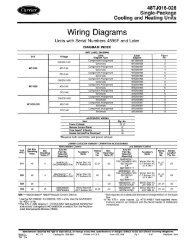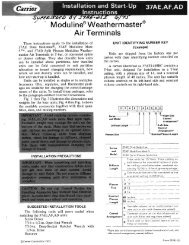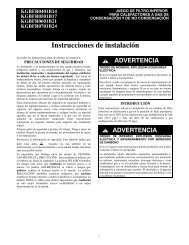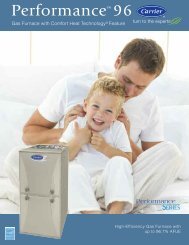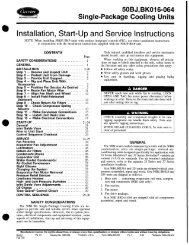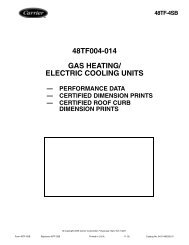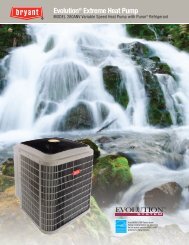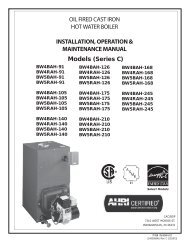Start-Up, Operation, and Maintenance Instructions
Start-Up, Operation, and Maintenance Instructions
Start-Up, Operation, and Maintenance Instructions
Create successful ePaper yourself
Turn your PDF publications into a flip-book with our unique Google optimized e-Paper software.
Check Optional Pumpout System Controls<br />
<strong>and</strong> Compressor — Controls include an on/off switch,<br />
a 3-amp fuse, the compressor overloads, an internal thermostat,<br />
a compressor contactor, <strong>and</strong> a refrigerant high pressure cutout.<br />
The high pressure cutout is factory set to open at 161 psig<br />
(1110 kPa) <strong>and</strong> reset at 130 psig (896 kPa). Ensure the watercooled<br />
condenser has been connected. Loosen the compressor<br />
holddown bolts to allow free spring travel. Open the compressor<br />
suction <strong>and</strong> discharge the service valves. Ensure oil is visible<br />
in the compressor sight glass. Add oil if necessary.<br />
See the Pumpout <strong>and</strong> Refrigerant Transfer Procedures <strong>and</strong><br />
Optional Pumpout System <strong>Maintenance</strong> sections, pages 67 <strong>and</strong><br />
75, for details on the transfer of refrigerant, oil specifications,<br />
etc.<br />
Table 9 — Control Test Menu Functions<br />
TESTS TO BE<br />
DEVICES TESTED<br />
PERFORMED<br />
1. CCM Thermistors Entering Chilled Water<br />
Evaporator Refrigerant Temperature<br />
(ICVC only)<br />
Leaving Chilled Water<br />
Entering Condenser Water<br />
Leaving Condenser Water<br />
Remote Reset Sensor<br />
Comp Discharge Temp<br />
Oil Sump Temp<br />
Comp Motor Winding Temp<br />
Space Temperature 1<br />
Space Temperature 2<br />
2. CCM Pressure<br />
Evaporator Pressure<br />
Transducers<br />
Condenser Pressure<br />
Oil Pump Delta P<br />
Condenser Water Delta P<br />
Transducer Voltage Ref<br />
3. Pumps Chilled Water — Confirm pressure<br />
Condenser Water — Confirm<br />
Delta P<br />
4. Discrete Outputs Oil Heater Relay<br />
Hot Gas Bypass Relay<br />
Tower Fan Relay Low<br />
Tower Fan Relay High<br />
Alarm Relay<br />
Shunt Trip Relay<br />
5. Guide Vane Actuator Open/Close<br />
6. Diffuser Actuator Open/Close<br />
7. Pumpdown Lockout When using pumpdown/lockout,<br />
observe freeze up precautions when<br />
removing charge:<br />
Instructs operator which valves to<br />
close <strong>and</strong> when.<br />
<strong>Start</strong>s chilled water <strong>and</strong> condenser<br />
water pumps <strong>and</strong> confirms flows.<br />
Monitors<br />
Evaporator pressure<br />
Condenser pressure<br />
Evaporator temperature during<br />
pumpout procedures<br />
Turns pumps off after pumpdown.<br />
Locks out compressor.<br />
8 Terminate Lockout <strong>Start</strong>s pumps <strong>and</strong> monitors flows.<br />
Instructs operator which valves to<br />
open <strong>and</strong> when.<br />
Monitors<br />
Evaporator pressure<br />
Condenser pressure<br />
Evaporator temperature during<br />
charging process<br />
Terminates compressor lockout.<br />
63<br />
High Altitude Locations — Because the chiller is initially<br />
calibrated at sea level, it is necessary to recalibrate the<br />
pressure transducers if the chiller has been moved to a high altitude<br />
location. See the calibration procedure in the Troubleshooting<br />
Guide section.<br />
Charge Refrigerant into Chiller<br />
The transfer, addition, or removal of refrigerant in spring<br />
isolated chillers may place severe stress on external piping<br />
if springs have not been blocked in both up <strong>and</strong> down<br />
directions.<br />
Always operate the condenser <strong>and</strong> chilled water pumps<br />
during charging operations to prevent freeze-ups.<br />
The st<strong>and</strong>ard 19XR chiller is shipped with the refrigerant<br />
already charged in the vessels. However, the 19XR may be ordered<br />
with a nitrogen holding charge of 15 psig (103 kPa).<br />
Evacuate the nitrogen from the entire chiller, <strong>and</strong> charge the<br />
chiller from refrigerant cylinders.<br />
CHILLER EQUALIZATION WITHOUT A PUMPOUT<br />
UNIT<br />
When equalizing refrigerant pressure on the 19XR chiller<br />
after service work or during the initial chiller start-up, do<br />
not use the discharge isolation valve to equalize. Either the<br />
motor cooling isolation valve or the charging hose (connected<br />
between the pumpout valves on top of the cooler<br />
<strong>and</strong> condenser) should be used as the equalization valve.<br />
To equalize the pressure differential on a refrigerant isolated<br />
19XR chiller, use the terminate lockout function of the CON-<br />
TROL TEST on the SERVICE menu. This helps to turn on<br />
pumps <strong>and</strong> advises the operator on proper procedures.<br />
The following steps describe how to equalize refrigerant<br />
pressure in an isolated 19XR chiller without a pumpout unit.<br />
1. Access terminate lockout function on the CONTROL<br />
TEST screen.<br />
2. IMPORTANT: Turn on the chilled water <strong>and</strong> condenser<br />
water pumps to prevent freezing.<br />
3. Slowly open the refrigerant cooling isolation valve. The<br />
chiller cooler <strong>and</strong> condenser pressures will gradually<br />
equalize. This process takes approximately 15 minutes.<br />
4. Once the pressures have equalized, the cooler isolation<br />
valve, the condenser isolation valve, <strong>and</strong> the hot gas isolation<br />
valve may now be opened. Refer to Fig. 29 <strong>and</strong> 30,<br />
for the location of the valves.<br />
Whenever turning the discharge isolation valve, be sure to<br />
reattach the valve locking device. This prevents the valve<br />
from opening or closing during service work or during<br />
chiller operation.







